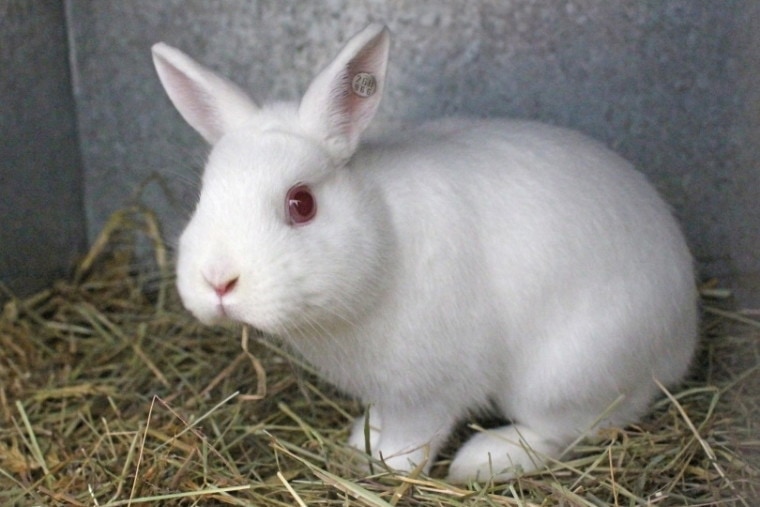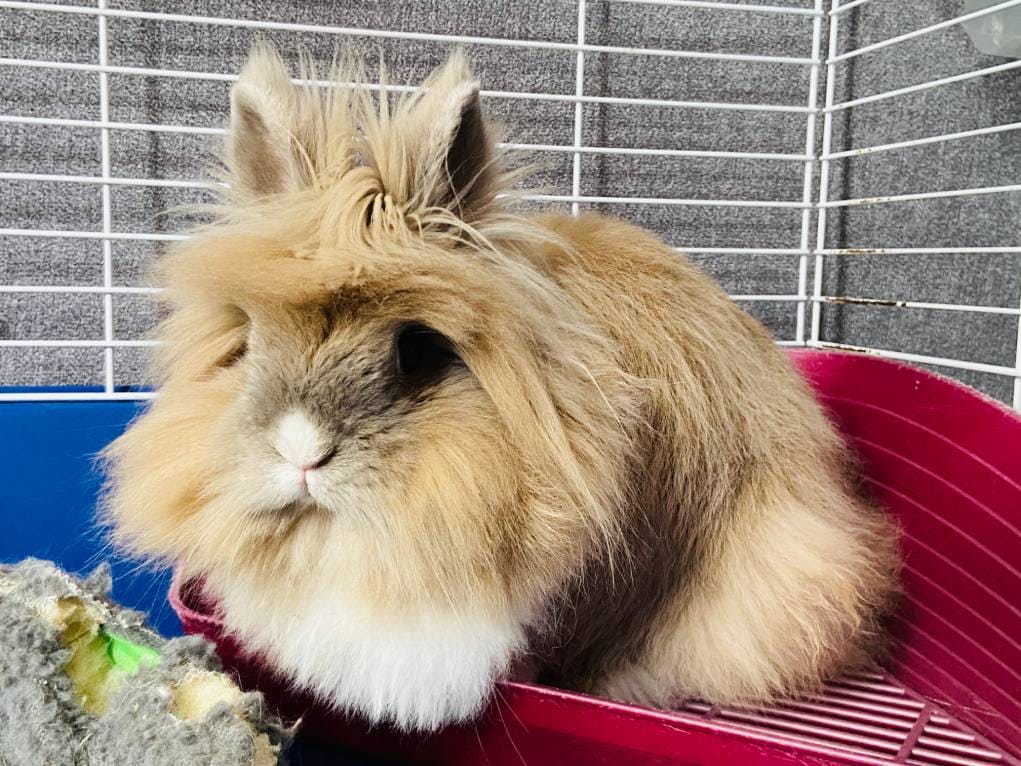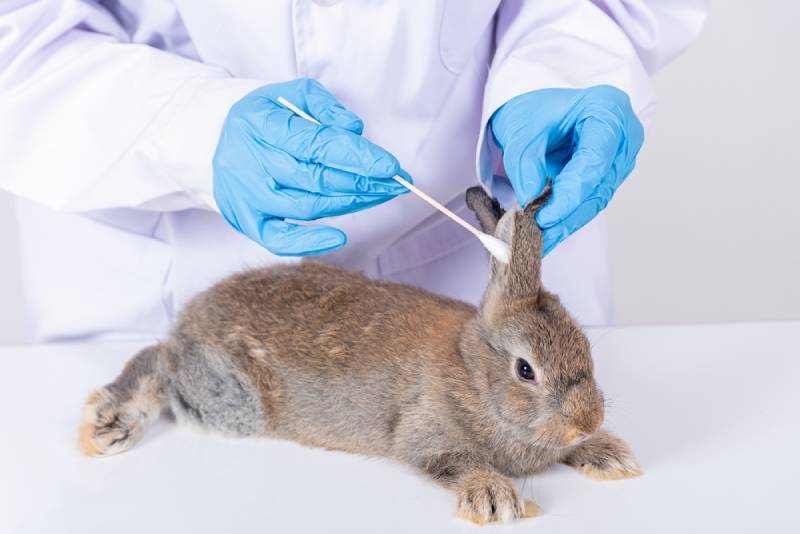
Click to Skip Ahead
Are you considering getting a Britannia Petite rabbit as a pet? These pint-sized bunnies are known for their adorable looks and friendly temperament, making them a popular choice for pet owners. But before you bring one home, it’s important to understand how to properly care for them. Their unique personality traits to their ideal habitat and dietary requirements, we’ve got you covered.
| Size: | Miniature |
| Weight: | 1.5–2.5 pounds |
| Lifespan: | 6–10 years |
| Similar Breeds: | Lionhead rabbit, Angora rabbit, Netherland Dwarf rabbit, Holland Lop, Mini Lop, and Rex rabbit |
| Suitable for: | Experienced rabbit owners with other rabbits |
| Temperament: | Spunky & energetic, high-maintenance, and active |
The Britannia Petite rabbit is a breed of domestic rabbit that originated in England in the 19th century. It was developed through selective breeding using the Netherland Dwarf, Polish, and Himalayan breeds. The breed was first introduced in the United States in the early 20th century and quickly gained popularity due to its small size and gentle temperament.
The Britannia Petite Rabbit is one of the smallest breeds of rabbit, weighing only 2–2.5 pounds when fully grown. Its compact size and short, fine fur make it easy to care for and keep as a pet. The breed comes in a variety of colors, including black, blue, chocolate, and lilac.
This rabbit remains a popular breed among rabbit enthusiasts and pet owners alike. It’s known for its spunky and sociable nature, making it an ideal choice for active singles or families. In addition to being kept as pets, Britannia Petite Rabbits are also shown at rabbit shows and competitions around the world.
Britannia Petite Rabbit Breed Characteristics
How Much Do These Rabbits Cost?
The price of a Britannia Petite rabbit can vary depending on where you live and where you purchase the rabbit. On average, you can expect to pay anywhere from $50 to $100 for a pet-quality bunny. However, if you are looking for a show-quality rabbit with pedigrees, the cost can be much higher. So, it’s important to note that the cost of owning a rabbit goes beyond the initial purchase price. If you’re interested in purchasing a Britannia Petite rabbit, it’s important to do your research and find a reputable breeder or rescue organization. A good breeder will be able to provide you with information about the rabbit’s health history and temperament, as well as answer any questions you may have about caring for your new pet.
Temperament & Intelligence of the Britannia Petite Rabbit
Do These Rabbits Make Good Pets?👪
Yes, but they can be a handful. These rabbits are known to be relatively easy to own, provided that their basic needs are met. These small bunnies require a bit more patience than other rabbits and can be a bit high strung overall. They’re super active and have a lot of energy. Like all rabbits, Britannia Petites require a clean and spacious living environment, a healthy and balanced diet, and regular exercise. However, because they are small in size, they do not require as much space as larger breeds of rabbits.
Does This Rabbit Get Along With Other Pets?
Britannia Petite rabbits are social and friendly by nature, and they can get along well with other pets if introduced properly. However, it is important to remember that every animal has its own unique personality, and some may not be as accepting of other pets. So, it’s important to supervise their interactions and introduce them gradually.
In general, Britannia Petite rabbits tend to be well-behaved around other small pets like guinea pigs and hamsters. However, they may see larger pets like dogs and cats as a potential threat. It’s recommended to introduce them in a controlled environment and always supervise their interactions until you are confident they can coexist peacefully.
You’ll also want to provide each pet with their own space and resources, such as food bowls, toys, and hiding places. This will help prevent any potential conflicts over resources and ensure that each pet feels safe and secure in their own environment.
Things to Know When Owning a Britannia Petite Rabbit:
Food & Diet Requirements🥕
Britannia Petite rabbits have specific dietary requirements that need to be met to keep them healthy. When it comes to their dietary needs, the number of calories they need per day will depend on various factors such as age, weight, and activity level. Generally, the average adult Britannia Petite Rabbit requires around 120–150 calories per day. However, this can vary depending on their individual needs–but they should be fed a high-fiber diet. The majority of their diet should consist of hay, which provides fiber and helps keep their teeth healthy. They also need fresh vegetables, such as carrots, leafy greens, which provide essential vitamins and nutrients.
In addition to hay and vegetables, Britannia Petite rabbits also need a small amount of pellets to ensure they are getting all the necessary nutrients. It’s important to choose high-quality pellets that are specifically formulated for rabbits and avoid overfeeding them.
Habitat & Hutch Requirements🏠
This small breed requires a relatively small living space. They’re an active breed that needs ample room to hop and play, so their habitat should be big enough for the rabbit to take at least 3 hops (per the Rabbit Welfare Association and Fund) from end to end. It should be big enough so that the rabbit can hop, stand, turn around, and move around comfortably. The hutch should also have a solid bottom to protect the rabbits from predators, and a roof that provides shade and protection from rain and other harsh weather conditions.
The hutch should be located in a clean, dry, and well-ventilated area that is protected from extreme temperatures. It is also important to make sure that the hutch is cleaned regularly to prevent the buildup of waste and bacteria, which can cause health problems for the rabbits.
In addition to the hutch, Britannia Petite rabbits also benefit from having access to an outdoor play area. This area should be securely fenced and free from any potential hazards, such as poisonous plants or sharp objects.
Exercise & Sleeping Needs🐇
In addition to providing ample space for exercise, it’s important to give your Britannia Petite rabbit plenty of opportunities to engage in physical activity throughout the day. Ideally, they’ll spend anywhere from 1 to 3 hours a day engaging in physical activities. You can help with this by providing toys and playthings for them to interact with, as well as opportunities for supervised playtime outside of their enclosure.
When it comes to sleeping needs, Britannia Petite rabbits are fairly active creatures and typically require about. However, they still need a quiet and comfortable place to rest and recharge. Providing a cozy sleeping area within their enclosure, such as a soft bed or nest box, can help ensure that your rabbit gets the rest they need to stay healthy and happy.
Training 🥎
Yes, you can train a Britannia Petite rabbit just like any other rabbit breed. Training your pet rabbit is a great way to bond with them and to ensure that they behave well around humans and other animals. Here are some tips to help you train your Britannia Petite rabbit.
The first thing that you should focus on is setting up a comfortable and safe environment for your new rabbit. This means providing them with a spacious cage that has plenty of toys, water, and food. A comfortable environment will make it easy for your rabbit to learn new things. Once your rabbit feels comfortable in their home habitat, you can start training them.
The best way to train your Britannia rabbit is through positive reinforcement. This means rewarding good behavior with treats or praise. So, what does this look like exactly? Well, it means providing your rabbit with easy instruction–your rabbit does something good, give them a small treat, or pet them to show that you’re pleased.
For example, one of the most important things you can teach your rabbit is how to use a litter box. Most rabbits are naturally clean animals and will learn how to use a litter box quickly. However, if your rabbit is still young or has never used a litter box before, you may need to be patient and persistent. Whenever your rabbit uses the litter box, give them a treat, or praise them to reinforce the behavior.
Another important thing you can teach your rabbit is how to come when called. To do this, you should start by saying your rabbit’s name every time you feed them. Your rabbit will soon associate their name with food and will come running whenever they hear it. Once your rabbit is coming when called reliably, you can start using this technique to teach them other behaviors.
Remember that training a Britannia Petite rabbit takes time and patience. You may not see results overnight, but with practice and persistence, your rabbit will learn new things and become a well-behaved pet. Just remember to be patient, positive, and consistent in your training approach.
Grooming✂️
Trimming
Though small, these rabbits have a thick fur coat that keeps them warm during the cold weather. So, there will be instances where a rabbit’s fur needs trimming. When it comes to trimming your Britannia Petite rabbit’s fur, it is best to do so during the warmer months when they don’t need their thick coat to keep them warm. It’s also important to use the right tools when trimming a rabbit’s fur. A pair of scissors or clippers designed for pets can be used to trim the fur. However, it’s important not to trim too close to the skin, as this can cause injury or irritation.
Bathing
As a general rule, it’s not recommended to wash a rabbit in the bath. Rabbits are delicate animals with sensitive skin, and they can easily become stressed when placed in unfamiliar environments or situations. Bathing can be particularly stressful for rabbits, as they aren’t adapted to water and may panic or become agitated when submerged–especially these little sometimes-feisty bunnies. In addition, rabbits have a natural cleaning process that involves grooming themselves with their tongues, so they don’t really require regular bathing like other animals.
But if your Britannia Petite rabbit does get dirty or soiled, it’s usually best to simply spot-clean them rather than giving them a full bath. This can be done by using a damp cloth or towel to gently clean the affected area. If your rabbit has a particularly dirty or matted coat, you can also try using a dry shampoo designed specifically for rabbits. These products are formulated to clean and deodorize without the need for water, making them a safer and less stressful option than a traditional bath.
Overall, while it may be tempting to give your rabbit a bath, it’s really important to remember that this can be a stressful and potentially dangerous experience for them.
Nail Trimming
Your Britannia Petite’s claws should be trimmed regularly. Trimming a rabbit’s claws is not only important for the rabbit’s health but also for the safety of the owner and other pets in the household. Overgrown claws can cause discomfort and pain to rabbits and can even lead to infections and injuries.
But when should you trim your rabbit’s claws? It’s recommended to trim them every 4–6 weeks, depending on how fast they grow. However, if your rabbit spends most of its time outside or on rough surfaces, the claws may wear down naturally and may not need trimming as often. It helps to observe your rabbit’s behavior and check their claws regularly to determine when they need to be trimmed.
Trimming a rabbit’s claws may seem like a daunting task, but it can be done easily with a good pair of clippers and some patience.

Lifespan and Health Conditions🏥
These rabbits have an average life span of 8 to 10 years, although some may live longer with proper care and attention. As with all rabbits, the life span of the Britannia Petite Rabbit can be affected by a variety of factors such as genetics, diet, exercise, and overall health. So be sure to monitor these factors closely and provide regular vet care to address any issues that may arise. Let’s look at a few common health conditions associated with this breed.
GI Issues
These small rabbits are also at risk for developing gastrointestinal stasis. This condition occurs when the gut stops functioning correctly, leading to a lack of appetite, bloating, and constipation. It can be caused by a poor diet, stress, or an underlying medical condition. Owners can prevent gastrointestinal stasis by providing a balanced diet consisting of hay, fresh vegetables, and high-quality pellets. It is also essential to provide plenty of water and encourage exercise and playtime.
Respiratory and Ear Infections
Other serious health issues that Britannia Petite rabbits (and many other breeds) may face include respiratory infections, ear infections, and myxomatosis. Respiratory infections are caused by bacteria or viruses and can lead to symptoms like sneezing, coughing, and discharge from the nose and eyes. Ear infections can occur due to poor hygiene or an underlying medical condition.
Myxomatosis
Myxomatosis is a viral infection that affects domestic rabbits and can lead to skin lesions, fever, and swelling around the eyes and head. Vaccinations and regular checkups can help prevent such infections.
UTIs
Urinary tract infections (UTIs) are also common in Britannia Petite rabbits. These infections can occur due to bacterial overgrowth or an underlying medical condition. Signs include frequent urination, straining during urination, blood in urine, and lethargy. Owners should provide plenty of fresh water and encourage urination by providing litter boxes and play areas. If signs persist, it is essential to consult a veterinarian as UTIs can lead to more severe conditions if left untreated.
Dental Issues
Rabbits aren’t unfamiliar with dental problems, and this breed is no different. One of the most common serious health conditions in Britannia Petite rabbits is dental problems. Due to their small size, these rabbits have small teeth, which can cause malocclusion or improper alignment of teeth. This condition can lead to overgrown teeth, causing a lot of pain and discomfort while eating and even leading to dental abscesses. Regular dental checkups and a diet rich in hay and fresh vegetables can help prevent such issues.
 Male vs Female
Male vs Female
Although male and female rabbits share many similarities, there are several differences that distinguish them.
One of the most notable differences between female and male Britannia Petite rabbits is their physical appearance. Males tend to be slightly larger than females, with a more muscular build. They also have a broader head and thicker necks than females. In contrast, females will have a smaller, more delicate build, with a narrower head and neck. Additionally, male rabbits tend to have longer, thicker fur around their necks than females.
Another key difference between the female and male Britannia Petite rabbits is their behavior and temperament. Males tend to be more territorial and aggressive than females, particularly when it comes to marking their territory or defending their food. This can make them more challenging to handle and care for than females. Conversely, female rabbits tend to be more docile and sociable, making them better pets for families with children or other pets.
One area where female and male Britannia Petite rabbits are similar is in their dietary needs. Both sexes require a balanced diet that is high in fiber, with plenty of fresh vegetables and water. It’s important to avoid overfeeding both male and female rabbits, as obesity can lead to serious health problems such as heart disease, diabetes, and joint problems. Regular exercise is also essential for keeping these rabbits healthy and happy.
3 Little-Known Facts About Britannia Petite Rabbits
1. They have a unique coat
One interesting fact about the Britannia Petite Rabbit is that they have a unique coat coloration called the “broken” pattern. This pattern consists of a white base coat with colored spots or patches spread evenly across their body. The broken pattern is a distinct feature that sets them apart from other rabbit breeds.
2. They live a long time
Another interesting fact about the Britannia Petite Rabbit is that they have a lifespan of 6–10 years. This is longer compared to other small breeds of rabbits, which typically have a lifespan of 3–5 years. A healthy diet and proper care can help extend their lifespan even further.
3. They’re rather spunky
These rabbits are known for their high-energy personalities–so be prepared for a rabbit that’s always on the go. They’re active, excitable, and playful animals that enjoy running around and exploring their surroundings. Potential owners should also know that these small rabbits can be skittish when placed in new environments or when they come in contact with other pets, so careful introductions are crucial.
Final Thoughts
These rabbits have a friendly and social nature, and they love to interact with their owners. They’re intelligent animals and can be easily trained to use litter boxes and perform tricks. But they may not be suitable for new pet owners or those who don’t have time to dedicate to socializing them. They can be hyperactive, skittish, and have anxiety in certain situations. Overall, Britannia Petite rabbits can make wonderful pets for those willing to provide them with the care and attention they need.
Featured Image Credit: Xaya, Pixabay








